» Site Navigation

1 members and 1,619 guests
Most users ever online was 47,180, 07-16-2025 at 05:30 PM.
» Today's Birthdays

» Stats

Members: 75,937
Threads: 249,130
Posts: 2,572,295
Top Poster: JLC (31,651)
|
-
Re: My Bioactive Arid/Desert Enclosure for Trans-Pecos Rat Snake
Well here is an important update: I got my snake today! His prior owner said he purchased him at the 2015 Daytona show, so I'm guessing he is likely about 6 years old or maybe more. I did have him shipped, and thankfully everything went fine (apparently... I'm still in denial something won't go wrong somehow lol). The lady in the FedEx hub said I could check on him in the office, so I opened up the snake bag, poked at him a little, and saw this little face with two big eyeballs peek around a fold in the fabric. It was cute. All I did was verify he was alive, though; I didn't want to just take out a snake in a public place and stress him out.
He is in quarantine and I plan to leave him there till the end of the year and test him a few times for any issues. I only handled him long enough to take these photos, but he seems to be totally delightful. He moves very slowly (carefully, I would say?) compared to our Japanese rat snake, and will just sit there in my hand, which is something I really wanted in a snake to be honest, lol. He has been in one of his hides for the past few hours, but that is okay; he has had a weird 24 hours. Anyway, say hello to Chico! (and a cameo of my foster rabbit in the background lol)






In vivarium news, I wanted to show a photo of the seeds sprouting right now. I can pick out three or four different varieties that have sprouted (the grassy one, Indian wheat, is the most prominent, but I am unsure what the others are as of yet). I have been reducing the plant light output because, last time, it burnt some of the seedlings, and they seem to be doing better with just the tube daylight bulb and only about 4 hours of my LED plant grow light per day. I mist directly over the seedlings every day and pour a small amount of water (like some droplets) every few days.

----------
Animals in my house:
1.0 Green Iguana
1.0 New Zealand Rabbit
1.0 Blonde Trans-Pecos Rat Snake
1.0 Japanese Rat Snake
? Panda King Isopod Colony
6 Blue Death-Feigning Beetles
4 Hellburnt Diabolical Ironclad Beetles
-
The Following 3 Users Say Thank You to TofuTofuTofu For This Useful Post:
AutumnVanilla (09-14-2021),Bogertophis (09-14-2021),Caitlin (09-14-2021)
-
Welcome Chico!  From what you describe, he's just like all the TPs I've ever known- a very gentle, curious snake that moves yes, "carefully" when handled. Just a delightful pet that I'm sure you'll love living with. Looks like you picked a winner- 6 years old is a nice age to get a snake- he's well-started, not so delicate as a hatchling. I'm glad his shipping went well- it generally does. I guess we'll have to see if "blondes have more fun", eh? From what you describe, he's just like all the TPs I've ever known- a very gentle, curious snake that moves yes, "carefully" when handled. Just a delightful pet that I'm sure you'll love living with. Looks like you picked a winner- 6 years old is a nice age to get a snake- he's well-started, not so delicate as a hatchling. I'm glad his shipping went well- it generally does. I guess we'll have to see if "blondes have more fun", eh? 
Rudeness is the weak man's imitation of strength.
Eric Hoffer (1902 - 1983)
“The greatness of a nation and its moral progress can be judged by the way its animals are treated.” ~ Gandhi
-
The Following User Says Thank You to Bogertophis For This Useful Post:
TofuTofuTofu (09-14-2021)
-
I don't know about you, but I'll never get tired of these TP faces.  Or their mellow personalities. Or their mellow personalities.
Rudeness is the weak man's imitation of strength.
Eric Hoffer (1902 - 1983)
“The greatness of a nation and its moral progress can be judged by the way its animals are treated.” ~ Gandhi
-
The Following User Says Thank You to Bogertophis For This Useful Post:
TofuTofuTofu (09-14-2021)
-
So, inside the cage I have just been thinning out some of the more crowded seedlings and allowing certain ones to grow. Hopefully by the beginning of next year, they'll be strong enough to handle an adult snake moving in! There are a few species doing okay and I want to facilitate a variety if I can. I blast one half of the vivarium with my grow lamp for 2-3 hours per day but otherwise just leave the fluorescent daylight tube on a 13-hour schedule. I water a small amount every couple of days by unscrewing the top of the mister bottle and just pouring it rather than misting.
As for Chico, I have made another topic for this, but just wanted to put in here that he hasn't yet eaten. He was previously on rat pups and I'm trying to get him switched to mice; he is also a little chunky. I tried scenting a mouse with used rat bedding last week, and tonight have tied a mouse fuzzy to a rat pinkie with my hair to see if he'll eat it. So far tonight, he just wanted to explore and is sitting next to me on a table as I type this. I'm not worried about this, though; I'm optimistic that he'll eat for me eventually.
Chico is being trained with choice-based handling and I plan to target train him once he is switched to mice and is eating regularly. Tonight is actually the first time where I sat next to his cage and he willingly climbed onto me in order to explore the table next to the chair I was in. I have otherwise not actually "handled" him in the sense that most people picture handling, and have never just gone and picked him up from anywhere. While exploring, if he goes somewhere undesirable (such as behind his tub and on top of the modem box), I will redirect him with a hook and one hand if I need to. He is doing well with this and I hope it builds his confidence; so far, I think it is working, since he willingly climbed on me today. He is really slow and this helps a great deal in giving him "choices," as I don't have to constantly be redirecting him in the way that I would a frenetic snake.
----------
Animals in my house:
1.0 Green Iguana
1.0 New Zealand Rabbit
1.0 Blonde Trans-Pecos Rat Snake
1.0 Japanese Rat Snake
? Panda King Isopod Colony
6 Blue Death-Feigning Beetles
4 Hellburnt Diabolical Ironclad Beetles
-
The Following User Says Thank You to TofuTofuTofu For This Useful Post:
-
Well, it's a little strange that he's not eating yet, especially since you tried the scenting too, but I guess he's in no hurry. I've never had a new TP that didn't eat quickly, & regularly, but snakes all do have their own personalities.
Trans Pecos rat snakes are strange creatures- they can actually move quite fast when they want to nail prey, but in handling, your observation is the same as mine- that they move slowly & very cautiously & gracefully- as if tiptoeing, which is hard to do without toes.  It makes them a real pleasure to handle, and I don't know of any other kind of snake that behaves this way. It makes them a real pleasure to handle, and I don't know of any other kind of snake that behaves this way.
Rudeness is the weak man's imitation of strength.
Eric Hoffer (1902 - 1983)
“The greatness of a nation and its moral progress can be judged by the way its animals are treated.” ~ Gandhi
-
-
Oh, so, just fyi, he did eat today! I left it in overnight. He still had not eaten this morning, though, and I think he ate around midday. That is kind of gross, and the mouse/rat creature I created was sitting out probably 16 hours at least. I hope he doesn't get sick from it? May be a discussion for another topic, but I'm glad he ate at least.
----------
Animals in my house:
1.0 Green Iguana
1.0 New Zealand Rabbit
1.0 Blonde Trans-Pecos Rat Snake
1.0 Japanese Rat Snake
? Panda King Isopod Colony
6 Blue Death-Feigning Beetles
4 Hellburnt Diabolical Ironclad Beetles
-
The Following User Says Thank You to TofuTofuTofu For This Useful Post:
-
Re: My Bioactive Arid/Desert Enclosure for Trans-Pecos Rat Snake
 Originally Posted by TofuTofuTofu

Oh, so, just fyi, he did eat today! I left it in overnight. He still had not eaten this morning, though, and I think he ate around midday. That is kind of gross, and the mouse/rat creature I created was sitting out probably 16 hours at least. I hope he doesn't get sick from it? May be a discussion for another topic, but I'm glad he ate at least.
Great! And I wouldn't worry about it. That's probably what he's used to doing.  It's possible that the person you got him from thawed rodents in ways that allow more "ripeness" before they were handed out to the snakes, & as I recall, you said he was taking either fed live or drop-fed, right? And he probably PREFERS live, but if nothing live was forthcoming, he's used to eating the funky stuff as a last resort. It's possible that the person you got him from thawed rodents in ways that allow more "ripeness" before they were handed out to the snakes, & as I recall, you said he was taking either fed live or drop-fed, right? And he probably PREFERS live, but if nothing live was forthcoming, he's used to eating the funky stuff as a last resort.
At least he ate for now, & I hope you can get him eating when it's a little fresher- I wouldn't offer food again for at LEAST 2 weeks, & see if that helps also. He's still settling in, & the older a snake is, the weirder (more stressful) it is thought to be for them when they're re-homed. I wouldn't worry or hold it against him, & since you're not willing to do fresh-killed (which he'd probably be happier with) just be patient.
When I've raised TP hatchlings they take f/t prey easily, but if they've been raised for a while on fresh-killed or live, it makes them harder to convince. It's no different than changing our own food "tastes" from what we grew up eating.  He's still an adorable He's still an adorable  & in the future, he might start eating it faster, especially when "what he ordered" never materializes. & in the future, he might start eating it faster, especially when "what he ordered" never materializes.
When you offered him prey previously, it might be that you picked it up too soon when he didn't seem to want it right away, lol. I've seen a few snakes in the past that did the same thing, & each learned to eat faster with subsequent meals. TPs are not known for eating carrion either- they're NOT like king snakes that way. I'm so glad that he at least ate. 
Rudeness is the weak man's imitation of strength.
Eric Hoffer (1902 - 1983)
“The greatness of a nation and its moral progress can be judged by the way its animals are treated.” ~ Gandhi
-
The Following User Says Thank You to Bogertophis For This Useful Post:
TofuTofuTofu (10-09-2021)
-
It has been a while since my last update, but I wanted to post a sort of “final” larger update post for this project.
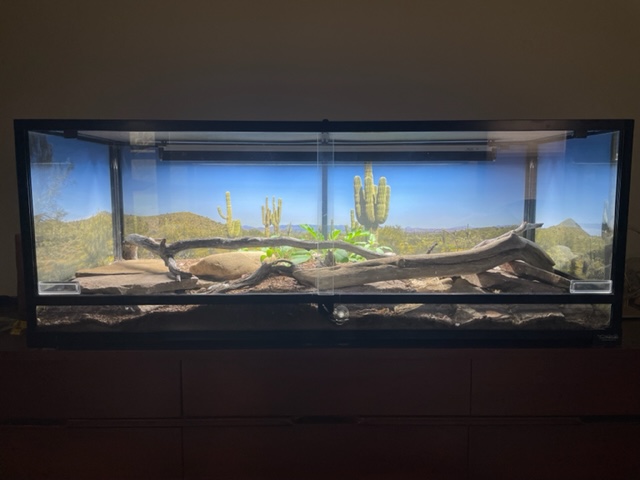
(the enclosure today)
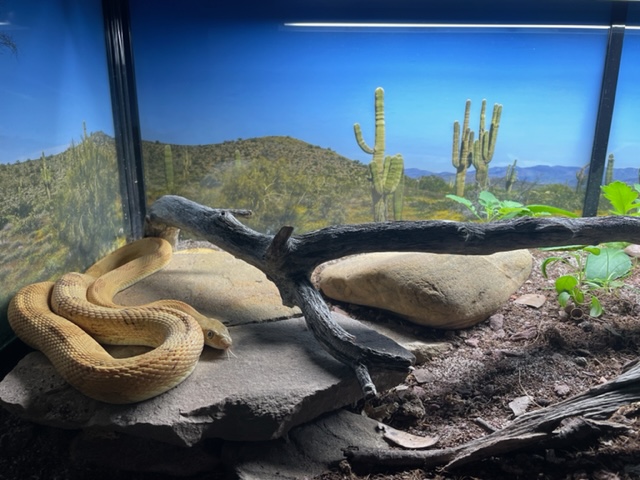
(Chico in his new home)
Rocks:
My Trans-Pecos ratsnake, Chico, was too big for the rock hides I had initially constructed. I removed my beetles, rearranged the rocks, and secured the rock formations with marine epoxy (probably does not need to be marine epoxy, but I had some in my house from another project). In doing this, I also had to move the existing plants, and I moved the ollas as well to better suit the plants.
I don’t have much guidance for making the rock hides; it took me hours of rearranging and pondering, and I bought a few extra rocks that were flatter in shape. My only concern about this was, in an emergency, how would I get him out of a hide? But the rocks are not glued to the floor of the cage, so I could technically life the entire rock hide if the house was burning down or something; it is just pretty heavy.
One hide was constructed above most of a heat mat (the heat mat I have is honestly pretty small, and takes up about 1/4 of the cage or less). The hide only has a thin layer of soil between it and the glass/the heat mat underneath. In both hides, I put a thin layer of (completely dry! Don’t dampen) sphagnum moss. Also, I did pack some sphagnum moss into any gaps in the rock hides that I thought my snake might get stuck in and hurt himself. This was a messy process where I dipped the sphagnum in the epoxy and packed it into the gaps, but it has worked out well.
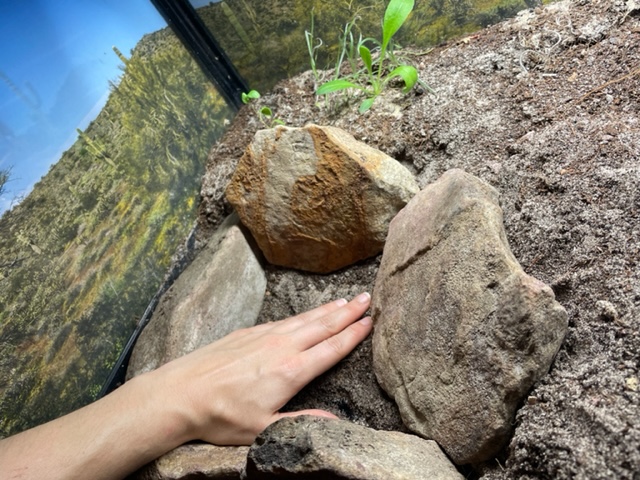
(before epoxy and rock layering)
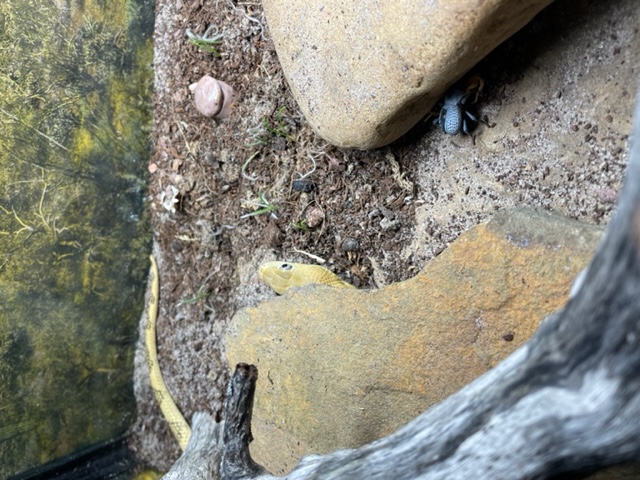
(sorry if this one shows up sideways; I can't fix it lol)
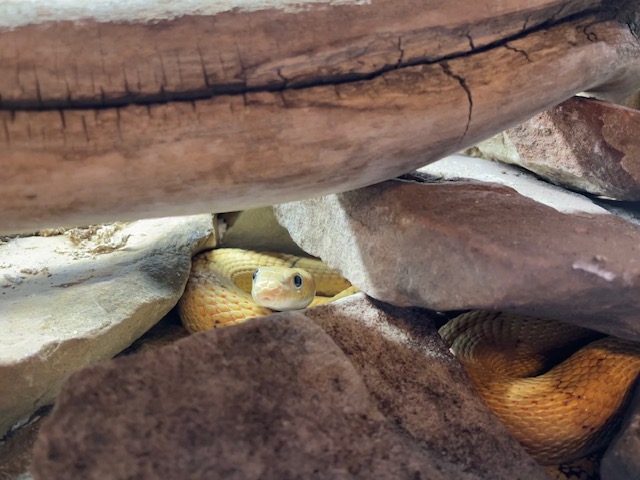
(Chico in the non-heated hide)

(heated side overall view)
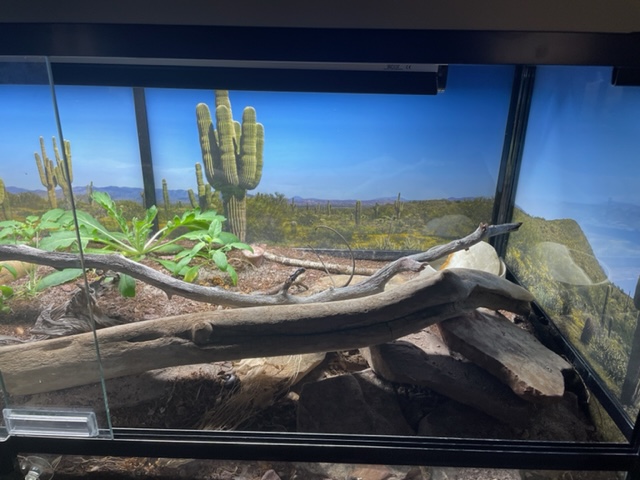
(non-heated side overall view)
Water:
There is a space in the back right corner for a water dish. I tried to position it so beetles couldn’t fall in; in addition, I put a rock in it so they wouldn’t drown and could climb out if they fell in. I haven’t seen one fall in yet (if they get wet, you can typically tell because some of their powdery coating is missing), but I will leave it like this permanently.
Transitioning into the enclosure:
I moved my Trans-Pecos ratsnake, Chico, into this enclosure in January. I did this gradually, by allowing him a few hours at a time to play in the enclosure while out for his regular explore time. I put one of his hides in there on top of the rocks. After about a week of explore time, where I let him stay in there for longer intervals of time, I let him stay overnight in the enclosure. Then, after a couple more days of explore time, I left him in there (still with his prior hide in case he wanted to use it). After about a week, I took out his old hide.
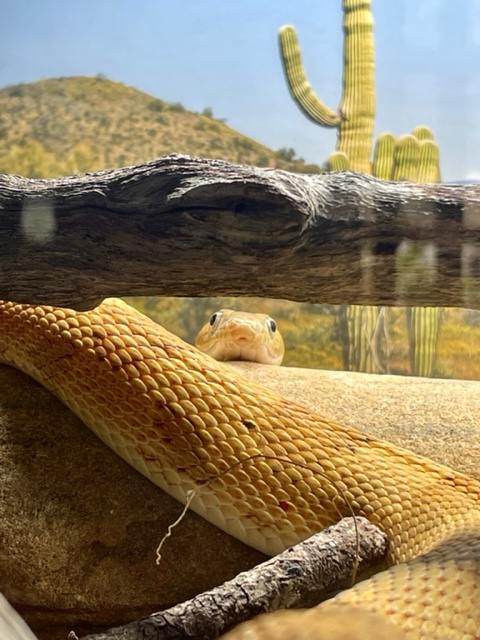
(I love his face)
Poo:
It dries out so fast in this enclosure. I remove it but if there are little bits of urates etc left over, I mix them in to the soil. I think the beetles do eat the urates? I haven’t seen whether they eat the poop yet, but I would think it would be much too slowly for me to want to leave it in there. This isn’t completely self-cleaning (and no bioactive enclosure is) and wasn’t intended to be.
Soil maintenance:
Several months apart, I think a small amount of my soil mix will need to be added. I judge this by the level of the ollas I can see above the soil, which tends to settle a bit over time. The blue death-feigning beetle larvae and the ollas themselves help prevent compression of the soil (watering top-down will flatten the soil faster, I think, and also I didn’t want surface soil moisture for this species). I plan to fertilize with kelp meal every 3-6 months or so? Bury this under the soil near plants.
Light:
I replaced the fluorescent tube light at the beginning of the year; the prior one had been in use for a little over a year. It hadn’t burnt out yet, but you are supposed to replace them and I thought it was no longer giving off the full daylight spectrum for my plants.
Plants:
The brittlebush (the largest plant previously) is living in a pot on my porch now. The other plants, which were seedings, were moved to more the middle of the setup. When transplanting, it is important to “mud in” the plants: make a hole for the plant; fill the hole with water; put the plant in the hole; put soil around the plant. They will look upset and take more water for about a week (if they look sad, water). I recommend understanding plants if you’re going to do this lol, or try to make sure you don’t need to move them. Normally, you shouldn’t need to move any of the plants unless you have to rearrange something in the enclosure, like I did.
Watering, I only do when a plant looks sad. If I see a SMALL amount of droop in the leaves, I will fill all of the ollas with water (this seems to be less than once per week but I’m honestly not keeping track). I emphasize “small” amount of droop because you don’t want the plants to look like they’re dead before you water.
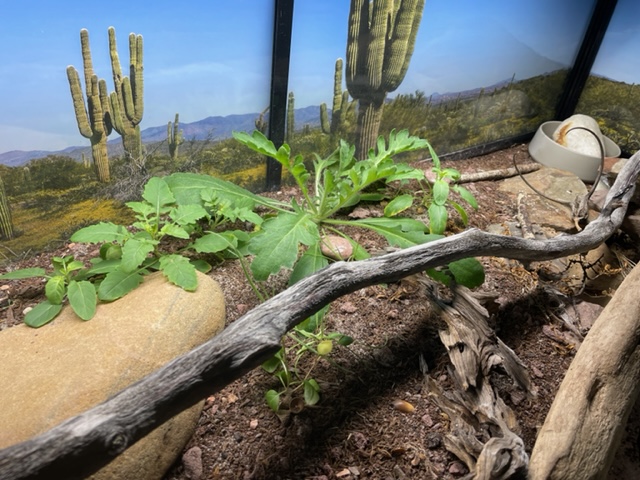
(My current plants from the desert seed mix. Unsure of the species yet)
Plantless:
I want to emphasized that overwatering would be really damaging to this setup. You can do this setup the exact same way but without plants, if you aren’t sure you want plants. I would recommend occasional (every two weeks or so) water on one side of the enclosure’s soil for the blue death-feigning beetle larvae (dig a divot/hole and fill up with water a few times, allowing it to disappear/drain between)
A special note about captive breeding blue death-feigning beetles:
In January, I saw a beetle that looked a little different; it seemed to have some clay soil on it, so I thought maybe had just dug around a but. I didn’t really investigate until the next day. To my complete shock, this was a new beetle. My blue death-feigning beetles have bred in captivity, without me even trying. I am completely sure this is a new beetle; all of my other beetles (despite me being able to identify them individually because of this), are “imperfect” ones missing limbs and parts of limbs; this new guy is totally “perfect.” The beetle is a little on the smaller side, about the same size as my smallest beetle of the group before it died, and it has a lighter powdery color than the others. After it emerged, it chomped on the shed skin for like a week straight, and is often running around with apparently lots of energy.

(the new guy!)
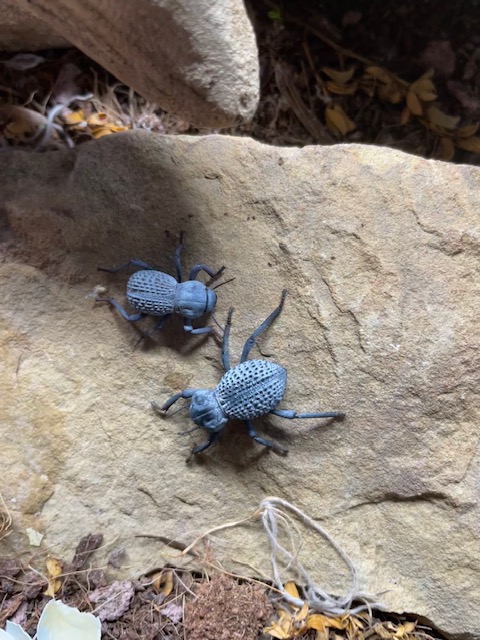
(new beetle above an existing beetle)
Also, while rearranging the hides (a day or two after I found the new guy), I found an absolute chonker of a larvae (whom I carefully put in a container while messing with the rocks and soil). Hopefully this means I will have another new beetle soon! My tally is still the same, as I did find a dead beetle while rearranging the cage; the number stays at 6 beetles now.
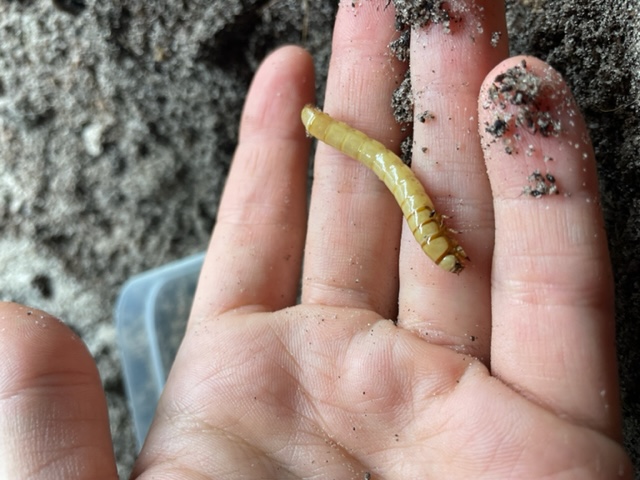
(big larva!)
To recap, all I have done for these beetles is:
- Bury a baby carrot or two in the soil every couple of months
- Feed the beetles vegetable scraps from stuff I cook
- Soil is mainly watered via the ollas and is not ever wet, but is occasionally damp in a smallish area
- I did bury small pieces of (live oak tree) twigs in the soil because I read they need wood to develop as larvae, but I’m really not sure this was needed, and also I would see the twigs come to the surface of the soil and they did not appear to be chewed on at all. There is no other wood in my soil mixture.
For something I could achieve accidentally that was previously made to sound difficult and precise, I now believe there is no good reason why blue death-feigning beetles cannot be captive bred. Hopefully in the future, CB blue death-feigning beetles will be widely available.
Socializing Chico:
Aside from the enclosure aspect, I wanted to make a short mention of my snake’s behavior and training. I followed choice-based handling with him, as he was initially shy and had never seen the outside of a tub his entire life. Following choice-based handling, he was a completely different snake in about a month, and even more of a different snake in three months. My Chico is curious and active and loves to explore. He is less shy about eating in that he will eat within about 5 minutes of me placing food, but still doesn’t understand what tongs are, so I just place the thawed mouse on a target. While we were able to easily target train our Japanese rat snake because he takes food from tongs, Chico will likely take a bit longer in this regard. However, the practical use of targeting (like unforcefully convincing them to exit their enclosure if you need to maintain something in it), has not yet applied to him, as he will freely approach me and come out to see me if I open the cage door for him. He is the least food-motivated animal I have ever seen lol. His personality is great and I’m happy he has learned to trust people and learned that exploring is fun.
In conclusion!:
I hope this series of posts helps anyone trying to make a similar enclosure. Unfortunately I will not likely be checking in to be able to answer any questions—I’ve been off of "reptile social media" because I find it depressing overall—but hopefully I’ve explained my methods enough to help someone hoping to recreate this setup or make something similar.
I’m very happy with this project overall and am glad I took the chance in making a setup that I love, that looks the way I envisioned.
----------
Animals in my house:
1.0 Green Iguana
1.0 New Zealand Rabbit
1.0 Blonde Trans-Pecos Rat Snake
1.0 Japanese Rat Snake
? Panda King Isopod Colony
6 Blue Death-Feigning Beetles
4 Hellburnt Diabolical Ironclad Beetles
-
The Following 5 Users Say Thank You to TofuTofuTofu For This Useful Post:
Ailuros (04-25-2023),Bogertophis (02-19-2022),Erie_herps (02-19-2022),Homebody (02-23-2022),plateOfFlan (02-19-2022)
-
That enclosure is gorgeous! Congratulations on your beetle husbandry, & why am I not surprised that Chico is very lovable?  Around people, every Trans Pecos I've ever known has been mellow, curious & so adorable to live with. I'm so glad this is all working out so well- what a GREAT job you did, & thank you for sharing all this- it's very educational & inspiring. Around people, every Trans Pecos I've ever known has been mellow, curious & so adorable to live with. I'm so glad this is all working out so well- what a GREAT job you did, & thank you for sharing all this- it's very educational & inspiring. 
Rudeness is the weak man's imitation of strength.
Eric Hoffer (1902 - 1983)
“The greatness of a nation and its moral progress can be judged by the way its animals are treated.” ~ Gandhi
-
 Posting Permissions
Posting Permissions
- You may not post new threads
- You may not post replies
- You may not post attachments
- You may not edit your posts
-
Forum Rules
|













 Reply With Quote
Reply With Quote
 From what you describe, he's just like all the TPs I've ever known- a very gentle, curious snake that moves yes, "carefully" when handled. Just a delightful pet that I'm sure you'll love living with. Looks like you picked a winner- 6 years old is a nice age to get a snake- he's well-started, not so delicate as a hatchling. I'm glad his shipping went well- it generally does. I guess we'll have to see if "blondes have more fun", eh?
From what you describe, he's just like all the TPs I've ever known- a very gentle, curious snake that moves yes, "carefully" when handled. Just a delightful pet that I'm sure you'll love living with. Looks like you picked a winner- 6 years old is a nice age to get a snake- he's well-started, not so delicate as a hatchling. I'm glad his shipping went well- it generally does. I guess we'll have to see if "blondes have more fun", eh? 
 It makes them a real pleasure to handle, and I don't know of any other kind of snake that behaves this way.
It makes them a real pleasure to handle, and I don't know of any other kind of snake that behaves this way.

 He's still an adorable
He's still an adorable  & in the future, he might start eating it faster, especially when "what he ordered" never materializes.
& in the future, he might start eating it faster, especially when "what he ordered" never materializes. 










